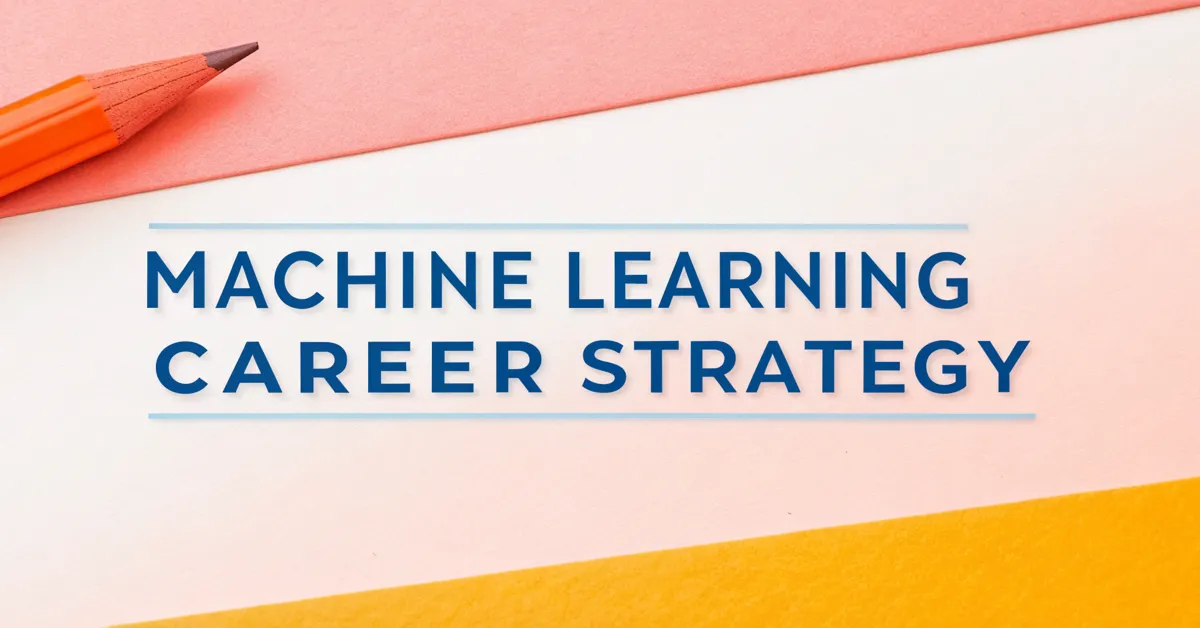Are you fascinated by the power of algorithms and the insights hidden within data? A career in machine learning might just be your calling. The field is booming, with companies across industries seeking skilled professionals who can build and deploy intelligent systems. But with so many paths to choose from, how do you map out a solid strategy for a successful machine learning career?
This field needs skill sets, and your journey needs to have a clear path to make sure you don’t go around in circles and feel lost.
In this article, you will learn the steps required to build a successful machine learning career.
Define Your Machine Learning Career Goals
Before diving into the technical details, you need to figure out your goals in the realm of machine learning. Where do you see yourself in five or ten years? A machine learning career encompasses diverse roles; it’s a must to clarify the specific area that calls to you the most. Here are some frequent career tracks:
- Machine Learning Engineer: Focuses on building, deploying, and maintaining machine learning models in production environments.
- Data Scientist: Concentrates on analyzing data, developing statistical models, and extracting insights.
- AI Researcher: Works on advancing the theoretical foundations of AI and machine learning through research and experimentation.
- Data Analyst: Specializes in gathering, cleaning, and interpreting data to support business decisions.
- AI Product Manager: Directs the development and launch of AI-powered products, aligning technical capabilities with market needs.
Knowing which of these excites you the most will help you focus your learning and make key career decisions.
Build a Strong Foundation in Mathematics and Statistics
Machine learning is deeply rooted in math and statistics. If you want to really understand how algorithms work and be able to tweak them, you need to know the underlying math. You will need to grasp these concepts:
- Linear Algebra: Essential for understanding how machine learning algorithms manipulate data.
- Calculus: Needed for optimization techniques used in training models.
- Probability and Statistics: Crucial for understanding the uncertainty and variability in data.
There are many ways to learn these topics. You can take courses online or at a local college. You can also read textbooks and work through practice problems.
- Khan Academy: Offers free courses on math and statistics.
- MIT OpenCourseware: Provides access to course materials from MIT, including linear algebra and calculus.
- “Introduction to Statistical Learning” by Gareth James, Daniela Witten, Trevor Hastie, and Robert Tibshirani: A popular textbook that covers the basics of statistical learning.
Master Programming Fundamentals
Programming is the bedrock of applying machine learning. You need to know how to code if you want to implement algorithms, handle data, and build models. Python is the dominant language in the machine learning world due to its simple syntax and the availability of powerful libraries.
- Python: The go-to language for machine learning.
- R: Used for statistical computing and data analysis, especially in academic settings.
- Java: Often used in enterprise environments for building scalable machine learning applications.
You should also learn the ins and outs of data structures (lists, trees, and graphs) and algorithms (sorting, searching, and dynamic programming). There are several good sources for learning programming fundamentals.
- Codecademy: Offers interactive coding courses, including Python.
- “Automate the Boring Stuff with Python” by Al Sweigart: A practical guide to learning Python by automating everyday tasks.
- LeetCode: A platform for practicing coding interview questions.
Deep Dive into Machine Learning Concepts
Now that you have a foundation in math, statistics, and programming, you can start learning about machine learning itself. Begin with the basics and then move on to more advanced topics.
Here are some key areas to study:
- Supervised Learning: Learning from labeled data.
- Unsupervised Learning: Discovering patterns in unlabeled data.
- Reinforcement Learning: Training agents to make decisions in an environment to maximize a reward.
Supervised learning includes algorithms like linear regression, logistic regression, and support vector machines (SVMs). Unsupervised learning includes algorithms like k-means clustering and principal component analysis (PCA). Reinforcement learning includes algorithms like Q-learning and deep Q-networks (DQN).
There are many resources available for learning machine learning concepts.
- Coursera and edX: Offer machine learning courses from top universities.
- Fast.ai: Provides practical, code-first machine learning courses.
- “Hands-On Machine Learning with Scikit-Learn, Keras & TensorFlow” by Aurélien Géron: A comprehensive guide to machine learning with Python.
Become Proficient with Machine Learning Libraries and Frameworks
Libraries and frameworks help to make machine learning easier. Here are some of the most popular ones.
- Scikit-learn: For general-purpose machine learning tasks.
- TensorFlow: For deep learning and neural networks.
- Keras: A high-level API for building neural networks on top of TensorFlow.
- PyTorch: Another popular framework for deep learning, known for its flexibility and ease of use.
These tools provide pre-built functions and classes that can help you implement complex algorithms without having to write everything from scratch. For example, you can use scikit-learn to train a linear regression model in just a few lines of code.
-
“`python
from sklearn.linear_model import LinearRegressionmodel = LinearRegression()
model.fit(X_train, y_train)
“`
There are many ways to learn these libraries and frameworks. You can read the documentation, work through tutorials, and build your own projects.
- TensorFlow Tutorials: Provides a range of tutorials for different skill levels.
- PyTorch Tutorials: Offers tutorials on various topics, including neural networks and computer vision.
- Scikit-learn Documentation: A comprehensive guide to the scikit-learn library.
Gain Hands-On Experience with Projects
Theory is important, but you really learn by doing. Working on projects helps you apply what you have learned and build a portfolio to showcase your skills.
Here are some potential project ideas:
- Image Classification: Train a model to classify images into different categories.
- Sentiment Analysis: Build a model to determine the sentiment of text.
- Recommendation System: Create a system to recommend products to users based on their preferences.
You can find datasets for these projects on websites like Kaggle and the UCI Machine Learning Repository.
When working on projects, it is important to follow these steps:
- Define the problem: What are you trying to solve?
- Gather data: Find or create a dataset that you can use to train your model.
- Preprocess the data: Clean and prepare the data for training.
- Choose a model: Select a machine learning algorithm that is appropriate for your problem.
- Train the model: Train the model on the data.
- Evaluate the model: Evaluate the model’s performance on a test set.
- Deploy the model: Deploy the model so that it can be used to make predictions on new data.
Working on projects is a good way to show potential employers what you know. You can use these projects to display your talent.
Build a Portfolio to Showcase Your Skills
A portfolio is a collection of your projects and accomplishments that you can show to potential employers. It is a powerful tool for demonstrating your skills and experience.
Your portfolio should include:
- Project descriptions: A brief description of each project, including the problem you were trying to solve, the data you used, and the results you achieved.
- Code: A link to the code for each project.
- Blog posts: Blog posts that you have written about machine learning.
- Presentations: Presentations that you have given about machine learning.
You can host your portfolio on websites like GitHub Pages or your website.
When building your portfolio, it is important to:
- Choose projects that are relevant to your career goals: If you want to work as a machine learning engineer, focus on projects that demonstrate your skills in building and deploying machine learning models.
- Highlight your accomplishments: Be sure to highlight the results you achieved in each project.
- Make it easy to read: Make it easy for potential employers to find your portfolio and understand your skills.
A good portfolio can help you stand out.
Network with Other Professionals
Networking is a great way to learn about new opportunities and make connections with other professionals in the field.
There are many ways to network with other machine learning professionals.
- Attend conferences: Attend machine learning conferences to meet other professionals and learn about the latest advances in the field.
- Join online communities: Join online communities like the Machine Learning subreddit and the Data Science Stack Exchange to connect with other professionals and ask questions.
- Attend meetups: Attend local machine learning meetups to meet other professionals in your area.
When networking, it is important to:
- Be prepared: Have a clear idea of your career goals and what you are looking for.
- Be polite: Be respectful of other people’s time and expertise.
- Follow up: Follow up with people you meet to stay in touch.
Being able to connect with others in your field is an advantage.
Tailor Your Resume and Cover Letter
Your resume and cover letter are your first impression to potential employers. It is important to tailor them to each job you apply for.
Your resume should include:
- Your education: List your degrees and any relevant coursework.
- Your experience: List your previous jobs and any relevant projects.
- Your skills: List your skills in math, statistics, programming, and machine learning.
- Your portfolio: Include a link to your portfolio.
Your cover letter should:
- Introduce yourself: Briefly introduce yourself and your career goals.
- Explain why you are interested in the job: Explain why you are interested in the specific job you are applying for and how your skills and experience make you a good fit.
- Highlight your accomplishments: Highlight your accomplishments in previous jobs and projects.
- Thank the employer for their time: Thank the employer for their time and consideration.
When tailoring your resume and cover letter, it is important to:
- Use keywords from the job description: Use keywords from the job description to show that you have the skills and experience the employer is looking for.
- Proofread carefully: Proofread your resume and cover letter carefully to catch any errors.
Prepare for Technical Interviews
Technical interviews can be nerve-wracking, but with proper preparation, you can nail them. A technical interview is a good way to check if the talent of an applicant matches the role requirement.
Here are some common types of questions you might be asked in a technical interview:
- Math and statistics: Questions about linear algebra, calculus, probability, and statistics.
- Programming: Questions about data structures, algorithms, and Python.
- Machine learning: Questions about machine learning algorithms, model evaluation, and data preprocessing.
- System design: Questions about designing and building machine learning systems.
To prepare for technical interviews, you should:
- Review your knowledge of math, statistics, programming, and machine learning: Make sure you have a strong understanding of the fundamentals.
- Practice coding: Practice coding interview questions on websites like LeetCode.
- Study system design: Study system design principles and practice designing machine learning systems.
- Practice, practice, practice: The more you practice, the more comfortable you will be with the interview process.
Stay Up-to-Date with the Latest Advances
Machine learning is a rapidly evolving field. New algorithms, techniques, and tools are being developed all the time. It is important to stay up-to-date with the latest advances.
There are many ways to stay up-to-date with the latest advances in machine learning.
- Read research papers: Read research papers on websites like arXiv and Google Scholar.
- Attend conferences: Attend machine learning conferences to learn about the latest advances in the field.
- Follow experts on social media: Follow experts on social media to stay up-to-date on the latest news and trends.
- Take online courses: Take online courses on new machine learning topics.
By staying up-to-date with the latest advances, you can keep your skills sharp and continue to grow as a machine learning professional.
Why Machine Learning Skills are the Keys to Unlock The Future
The ability to harness and interpret data is becoming an increasingly important skill. As the world produces data at an exponential rate, the demand for those who can transform this raw information into useful insights and practical applications is growing. This makes machine learning skills not just valuable, but vital for anyone looking to stay relevant in a transforming economy.
By mastering machine learning, you equip yourself with the tools to understand complex trends, automate processes, and create intelligent solutions that drive innovation and efficiency. Whether it’s in healthcare, finance, retail, or any other sector, the insights provided by machine learning can lead to breakthroughs that were once only imagined.
Is a Machine Learning Career For You?
A machine learning career path is a great journey. If you like math, if you enjoy coding, and if you are curious about AI and how things work, this career is for you. These skills will help you in a job that’s always changing and challenging. What you learn will always improve, so it’s a road where you always improve and adapt.















Leave a Reply
View Comments